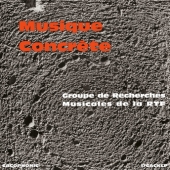
Various Artists
Musique Concrete - Groupe De Recherches Musicales De La Rtf
Label: Cacophonic / Finders Keepers
Genre: Jazz / Avant Garde
Availability
- LP €20.99 Dispatched within 5-10 working days
With word of his theories and experiments spreading, Schaeffer was able to press the RTF management to further finance and in doing so expand his research. However, for an undertaking of this size he would need help. Having previously collaborated as part of his early research with a young classically trained composer by the name of Pierre Henry, Schaeffer had no problem convincing the RTF executives he was the right man of the job. By adding a third prong to this sonic fork in the shape of sound engineer Jacques Poullin, Schaeffer was able to complete a powerhouse, which he renamed the Groupe de Musique Concrete, that would push his experiments further than he could have imagined. In1951, RTF handed the trio the keys to one of the earliest purpose-build electroacoustic studios (the other being the WDR Studio in Germany), furnishing it with state of the art bespoke equipment such as a Morphophone (designed by Poullin himself and capable of tape loop-delay) and a Phonogène (a multi-headed tape instrument also designed by Poullin). The studio went from strength to strength, attracting composers such as Karlheinz Stockhausen and Edgard Varèse to collaborate, and in that same year Schaeffer and Henry produced and premiered what is considered to be the first opera concrète, Orphèe 51.
As Schaeffer’s notoriety grew as did demand for his time and he found himself increasingly called away from the studio during which time he would hand the keys to over to his colleagues. Pierre Henry wasted no time in pursuing projects closer to his own heart, working with experimental filmmakers and choreographers like Maurice Béjart (the two would later collaborate with Michel Colombier on the cult classic Les Jerks Électroniques De La Messe Pour Le Temps Présent Et Musiques Concrètes Pour Maurice Béjart). In 1957, following a particularly prolonged absence on RTF duties, Schaeffer returned unhappy with the direction the group had taken and tabled an idea to revitalise both their approach as well as personnel. As a result, Henry and several other key members left the group the following year leaving Schaeffer to lay the foundations in 1958 for a new collective called Groupe de Recherches Musicales - one of a number of theoretical and experimental groups overseen by Saeffer’s Service de la Reserche at RTF - and set about recruiting new members including Iannis Xenakis, Henri Sauguet, Luc Ferrari and Michel Philippot as well as usher in a new steady stream of eager musicians eager to study within what had rapidly become (and still is) a national institution - including a young Jean Michel Jarre!<br /> <br /> Featuring the full versions of these seminal early works (abridged versions of which had previously appeared across two 7” singles on Disques BAM) the recordings presented here are the first fruits of this new alliance and served to lay the bedrock for the future of the Groupe de Recherches Musicales research which would later count the likes of Ivo Malec, Philippe Carson, Romuald Vandelle, Edgardo Canton and François Bayle (who went on to coin the term Acousmatic Music) amongst its members and cement its place in the annals of experimental, electroacoustic and early electronic music history.
